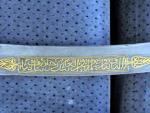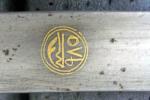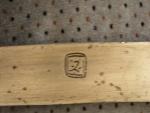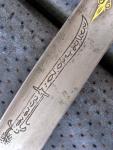-
Posts
4,862 -
Joined
-
Last visited
-
Days Won
15
Content Type
Profiles
Forums
Blogs
Gallery
Events
Store
Everything posted by peter monahan
-

"Broken Square"
peter monahan replied to Peter_Suciu's topic in Great Britain: Research, Documentation & History
Rudyard Kipling has a poem about the "Fuzzy-Wuzzy", written in a tone of admiration and in the voice of a "Tommy". "So 'ere's to you, Fuzzy-Wuzzy, at your 'ome in the Soudan; You're a poor benighted 'eathen but a first class fightin' man; We gives you your certificate, an' if you want it signed We'll come and 'ave a romp with you whenever you're inclined." "..But give an' takes the gospel, an' we'll call the bargain fair, For if you 'ave lost more than us, you crumpled up the square!' Peter -

Turkish Kinjal - request for info.
peter monahan replied to peter monahan's topic in Swords & Edged Weapons
Dan I'll try to post a shot later today P -
Here we go. In the late 19th/early 20th centuries the British raised units to patrol the Durand Line between British India and Afghanistan - the famed Waziristan Scouts, Tochi Scouts and Gilgit Scouts on the "poachers turned gamekeepers" idea. These were all "trans-Frontier Pathans" in the jargon of the time. They were famed for long range patrolling and incredible tenacity. After 1947 Pakistan raised further units. "By then, the First Mahsud Scouts, raised in 1937, had also been included in the Frontier Corps. In later years, the Second Mahsud Scouts (1944), the Pishin Scouts (1946), the Thall Scouts (1948), the Northern Scouts (1949), the Bajaur Scouts (1961), the Karakoram Scouts (1964), the Kalat Scouts (1965) and Dir Scouts (1970) [were raised}". I had badges for all and I'm pretty sure the Mountain Goat's head was the Karakoram Scouts.
-
The goatlike creature is not a cap badge? Yes, it is. I have/had one once but can't put my hands on it right now. It is for the Kukoram Scouts (I think) one of the North West Frontier units raised by the british and maintained by Pakistan to patrol the border with Afghanistan. More to follow. Peter
-

Turkish Kinjal - request for info.
peter monahan replied to peter monahan's topic in Swords & Edged Weapons
-
Gentlemen I was given this lovely blade a while back and am trying to find out a bit more about it, specifically where i might get a translation of the inscription (Persian & Koranic, I assume) and how I might identify the maker's marks stamped and gilded on the other side of the blade. Also, the handle and sheath are very plain for such a blade, it seems. Is this common? Any way to date it, even roughly? Any and all advice gratefully received! Peter
-
I came across an interesting letter this week while vacationing in a small town in north central Ontario (Minden, for the Canuks out there). No details as to how it got there. Here's what I found: A 5" x 7" piece of Buckingham Palace stationary, dated simply "1918" in the top center. Handwritten, apparently by one person and signed "George R I" by the same person. Two paragraphs, one describing the concern felt by His Majesty and the Royal Family throughout the war for the fate of the officers and men held as POWs (in Germany?) and the second expressing his happiness over the recipient (unnamed) being restored to his family. At the bottom is the signature and a notation which simply says "Pte. A. B. C.....", R.A.M.C." Sorry, I didn't write down the name. So clearly Pte. Whoever of the Royal Army Medical Corps was a POW for part of 1914-1918. But, was this letter exceptional or common? Did the King really write it/them or was some Palace flunky signing his name for him? Comments and suggestions welcome! Peter Monahan
-
"What rule did we shoot them under? Well we didn't carry rule books now did we. We were out on the veldt fighting the Boer the way he fought us! We caught them and we shot them under rule .303!" Dan Murphy Dan I agree that "Breaker Morant" is a great movie. The Aussies defence lawyer tells the court that "Before I came here I was poisoning wells and rounding up Boer women and children." [to put into "concentration camps"). The point is not that Morant and his men are shooting Boer prisoners but that they are pushed into it and have it winked at by their superiors, who can't come up with another way to win, then hung out to dry when the world objects. They're actually following Kitchener's orders when they shoot the Boers dressed in khaki but the court martial denies this. A "cracking good yarn" but also a fascinating look at the morality of war. One of my favourites! Peter
-

Denmark Danish? Artillery field cap
peter monahan replied to Avitas's topic in Northern European & Baltic States
The look also "feels" right for Spanish or Italian. When did italy give up the crown emblem? They were technically a monarchy again in late WWII when Victor Emmanuel told mussolini he was out. My 2 cents worth! peter -

R/Q/M Havildar
peter monahan replied to Riley1965's topic in Great Britain: Research, Documentation & History
Doc Mike Johnson and ed haynes can confirm this but my short answer, sadly, is "No." Unless you can find someone with a reg't history. A QM Havildar (Sergeant) would be Indian, not British and the records on the Indian ranks are probably buried in an archives in Rawalpindi or New Delhi. Sorry! Peter -
ErikMuller A very nice find indeed! Here's a little info on the campaign. I'm parphrasing Gordon's "British battles and medals" here: About 14 000 Abyssinian medals were issued for the expedition, under Lt General Sir Robert Napier, against "Mad" Emporer Theodore who had imprisoned a number of British subjects including the British Consul, a Captain Cameron. They were locked up in 1865, had their release negotiated by a missionary in 1866 and were re-arrested, along with the negotiator, a month later. A series of unanswered ultimatums emsued and Queen Victoria declared war in parliament November 19th, 1867. Essentially, the campaign involved a march from the coast to the capital, Magdala (about 300 miles / 500 km). The British fought one battle, at Arrogie on April 10, entered the capital on the 13th to find that the emporer had killed himself, burned the place down and went home. Total casualties 2 killed, 27 wounded. Nobody counted the dead Ethiopians. The native defenders of the capital were barraged by a Naval rocket battery and fled without firing a shot. The British won! One of the most exoensive medals to make because the names were emobossed on the reverse. The troops included many Indian regiments (horse and foot), 5 br infantry and 2 cavalry regts and lots and lots of service train - 40 000 men who didn't get the medal, plus 36 000 horses and mules, 7 000 camels and 44 elephants. Crews of 5 vessels serving in the Red Sea receieved the medal, though only 83 sailors went on the expedition. There's a bit more if you want it. Peter
-
It's true, ya know: we do kill them cruelly! They're live trapped, taken to Ottawa and chained in the back row of the House of Commons during debates on defence spending asnd reforms to the Tax Act. If that doesn't kill them, they're forced to follow a politician around the rubber chicken re-election circuit and listen to the same speech as many times as it takes! Don - on a serious note, I agree that tradition is no defence. Another site I haunt - bootmakers, mostly Texan - was bemoaning the loss of "good" ostrich skins - the ones where the feathers are plucked BEFORE the birds are killed 'cause it creates bigger "bumps" in the hide. That's a crime! I don't eat veal or pate foi gras either. But, as Michael points out, the bears get shot anyway as nusiances or for sport, so at least using the skin makes some use of the carcass and maybe feeds some guide or trapper's kids. My tuppence worth peter
-
Dolf, Kevin & Stephen Sorry if I sounded skeptical about the TV show. I usually am! My experience has been that television producers are far more interested in a good story than in good history but, not having seen it, I accept your view that it was well done. Syephen: all my questions answered. Thank you. As I said earlier, I've not studied this story/case at all and, clearly, what I thought I remembered from a cursory examination of the infamous seat was flat wrong. No bullet hole = Roy Brown didn't kill him, whatevere else he may have done (or not) to the plane. A fascinating mystery! Peter
-
To me, a more interesting (and important) story than any number of legendary lost treasures lies in the fate of the monies deposited by the NAZIs in swiss banks. It began as gold teeth, among other things, taken from Jews of various nationalities, and was sent to Zurich for safekeeping in case the "1000 year Reich" wasn't! Now the Swiss are reluctant to give it up. Go figure! They're not keeping it for the original depositers, their just keeping it! I take no position on who should get it or how - though I have opinions - but somebody other than the banks should be beneifitting from it. Who and how is a more complicated and less exciting story but still one worth some TV and newspaper time, i think. Sorry to add sucha "downer" note to a lighthearted thread! Peter
-
Stephen Your photos clearly trump my foggy 50 year old memory! I won't comment on the "shot on the ground" theory, though it neither surprises nor shocks me. (Sorry, bad stuff happens in wars. It shouldn't, but it does.) BUT, if Brown didn't shoot him, why did he land? Slugs in the engine? Surely this would have appeared in other accounts? Enquiring minds want to know! Peter
-
Here's a related note I think - but my train of thought often travels down strange tracks - interest owing from former "loans" The US government still owes the Catholic order the Sisters of Notre Dame monies for the medical care provided to three American officers wounded and captured at Benedict Arnold's abortive attempt to capture Quebec City in 1779. The original sum was, I believe, in the order of twenty dollars: care and lodging for three months for three men. With interest at a modest 1% per annum the delinquent payments now amount to some millions of dollars, though I don't suppose the good sisters are making any big buys on the expectation of getting the bucks anytime soon. This surfaced, BTW, when Canada was taken to task a few years ago for trading with Cuba who, among it's other sins, still owes money to US citizens for properties nationalized by the (filthy Commy) Castro regime. And don't even ask about the money owed to "Loyalists" (political refugees who fled to Canada after the Revolution) by various state assemblies! Joking aside, when does a "debt" / "loan" / etc get written off? I've heard that technically a small portion of the British national debt consists of monies borrowed from the US in 1917, but I can't imagine that Washington still sends out a bill every year. Interesting question, no? Peter
-

Japanese looted gold...
peter monahan replied to bigjarofwasps's topic in Coins & Commemorative Medallions
Wasps The soft-hearted general - having buried his countrymen alive - spares his valet. Nice touch! Nobody notices the arrival of "tons" of gold in remote rural areas of the Philippines, presumably transported there on IJN vessels none of whose crews wondered what the stuff was? The Americans (?) successfully extract it for use in the Cold War, again without any of the locals or the oh-so-gullible Phillipines government knowing or caring? No offence, but this sounds a lot like the letters I get every week from the Nationl Bank of Nigeria! Who do I send my money to to get in on this treasure trove? Peter -
Michael knows. There's a surprise! Well done, Michael! Peter
-
KPS The script looks like Thai or a related script to me - check wikepedia and see what you think. The style of the tiger is also very reminiscent of that part of the world. A couple of the letters - the first 2 on the top row, and the fifth on the top and first on the bottom row could definitely be Thai, as could the "57" in 8th place on the top. Not sure about the others. It doesn't look like Burmese - a more logical choice - to my untutored eye but I'd say definitely from that area (one of the scripts derived from ancient Khmer.) Good luck with the ID. Let us know what you find! Peter
-
Lovely medal. Can't help on the tracing myself but here's a short history of the Montreal Garrison Artillery, arguably one of Canada's first two regular forces units. As suggested by para. 4, they didn't actually fire any shots in anger but that's common for Fenian Raid Medal holders - 90% didn't. Still a very nice piece and quite saleable up here. Good luck with the research - I've also included a note on the medal roll book. This vendor is reliable, I believe. Peter PS: You might check out www.gunners.ca for more history of the unit. ============================================== A company of Royal Montreal Artillery was raised in 1828 and was used to patrol the city during the riots of November 1837. All Corps of this type were privately organized and financed. 3rd Montreal Field Battery, The battery was authorized on 27 September 1855 as the ?Volunteer Militia Field Battery of Artillery of Montreal, and exists today as 7th Fd Bty RCA. The battery began with three 6 pdr guns and one 12 pdr how and fired one of its first salutes for the 39th Regiment of Foot, returning from the Crimea in 1856. The Battalion of Montreal Artilllery was raised on 27 November 1856 (with 6 Btys) and was re-designated ?2nd (Montreal) Regiment of Garrison Artillery? in 1895. The Garrison Artillery were trained as static fortress Gunners and their roles would eventually change to manning the Heavy, Siege and Medium batteries of the two world wars. They are today perpetuated by the 50e Brie de Campagne, ARC. 3rd Montreal Field Battery was called out on 1 June 1866 and on 25 May 1870, but did not see action. Both the battery on the battalion provided personnel for ?E? Battery, RCFA which saw action in South Africa. Canada General Service Medal Roll 1866-70. Compiled by John R. Thyen. Medal Roll for all those who received the medal for the Fenian Raid, of 1866 and 1870 as well as the Red River 1870. Lists all British and Canadians who participated in the Campaigns. Hard Cover, 305 pages. Black and White pictures as well as maps.$39.95 http://www.marway-militaria.com/books.htm
-

Military use of the Gold Sovereign
peter monahan replied to bigjarofwasps's topic in Coins & Commemorative Medallions
Captain Caltrop said " The US Navy paid its bills in China with "Mex" or Mexican silver dollars during the early 20th Century. The Chinese were used to silver currency... it was a good neutral currency with no political overtones. During my days on the Asian Riviera we used to talk of "CIA bracelets" with detachable links of gold. It is likely that holding any foreign currency in a Communist country resulted in a summary death sentence so unornamented "raw gold" was the best tender. I think the point of such currencies was not their neutrality but the notion, arrived at by the locals for whatever reason, that they were "good' (ie. pure) metal. I don't suppose your average Toureg nomad or Chinese peasant knew or cared where Mexico or Austria was but they'd know silver or gold when they met it. Didn't Wellington have British silver coins re-cast as Spanish in the Peninsula because the locals wouldn't take foreign issues? I like the "CIA" idea though: "Just a lump of gold , boss. No idea where it came from. " Peter -

Military use of the Gold Sovereign
peter monahan replied to bigjarofwasps's topic in Coins & Commemorative Medallions
Two tidbits on this topic I read somewhere, years ago, that in North Africa the coin of choice was the Austrian Maria Theresa "thaler" ('dollar' to we Anglos) and that the Austrian mint kept making them well into the 20th century for use in such conditions as meeting possibly nasty Beduoin, Tuareg, etc. Can't vouch for the truth - I believe it was in a novel - but it struck me as the kind of thing that a novelist would think neat to include but be unlikely to make up. For what it's worth. Years ago I knew a Portugese chap would been in Angola as a national service soldier and stayed on. he claimed to have served with Mike Hoare and the South African mercenaries. Can't vouch for that either but he did recognize Brazzaville, Congo from an arial shot in a movie we were watching one night so... ? Anyway, we met in West Africa where he was working for a construction company and he showed me his "insurance policy": a ring with a half sovreign in it and a compartment in his wallet with 2 Krugerrand. Claimed it would get him across any border in Africa (ie: out of the country) in a pinch. I suspect he was right. That or shot! Peter -
Three things - and I'm not taking a position either way on who done it - about this version! 1. Basing the flight path on (written/oral) reports? Hello ? How detailed do you think ground observers bothered to be about planes flying overhead? Remember, no one knew till after that this was anybody important. Dogfights are by definition a series of dives, loops, stalls and so on. I'd suggggest that NOBODY can accurately plot the flight paths of two combat aircraft relative to anything except each other, even with a moviecam, unless both planes are flying against a background of gridded lines or some such. 2. My memory is 20 years old but fairly clear: it wasn't a rivet hole! It a single hole with jagged edges in the lower middle of the seat back - a good 2"-4" from the edges, not in a line of other holes, not machined. Don't know about calibre, didn't have a .303" round with me. But then I'm skeptical about ballistics too: I've seen a helmet with matching holes left and right about 2" (5cm) above the ears owned by the guy whose head the German bullet skated AROUND on it's way through. (ie: in on the right, carved a groove up and over, out on the left - impossible by the "laws of ballistics"). 3. If it were a rivet hole then the Baron wasn't shot thru his seat at all, so how did he die? And how would that make it likelier that it was ground fire rather than from a plane? (All the shooters were using .303, right?) I believe he was killed either by Roy Brown or by ground fire with a preference for choice 1 (A pilot killing a pilot) but I don't care much. However, sloppy forensics and writing in the pursuit of sensational TV and solving "historic mysteries' bug me! End of rant. Peter
-
Christophe There is a longstanding debate about whether the baron was killed by Brown or by Australian infantry fire from the ground. I haven't read on this at all, never mind in depth, but my impression is that modern scholars tend to accept the "Canadian version". Whether that's true or not, the seat from the Baron's plane now rests in the Canadian Military Institute in Toronto, Ontario. I've seen it- in fact spent 3 hours "guarding" it at a medal and militaria show years ago. Yes, it has a single bullet hole in the lower back area. Don't ask me whether it was made by a bullet going upwards or downwards, because I don't know! My two cents worth. Peter
-

Does anybody knows what this medals are?
peter monahan replied to a topic in Northern European & Baltic States
Tiger They somehow look French to me - but just a guess. The cross - white with the gold edges and "little ball thingies" at the points is the same as for the Legion of Honour but the rest is not. The French are also very found of palm circlets like those in the center. Kev is right: the suspension on the big one looks damaged or dodgy. French civilian - maybe municipal or a society of some sort - would be my guess, if not cheaper copies of something. But for $16.00 they might br fun to pick up as curiosities! My tuppence worth! Peter





